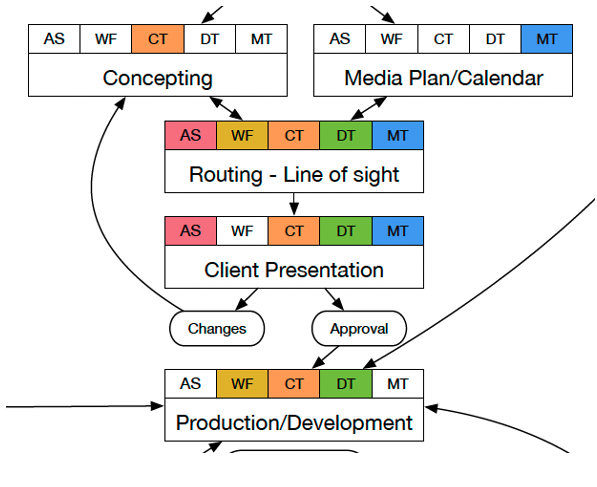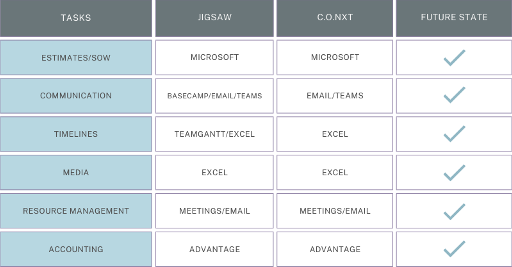In the ever-evolving landscape of the agency world, the word “process” is often met with disdain and resistance. We’ve all been there – when project fires are burning, processes are the first casualties, discarded in favor of hyper-focused task execution. However, as we begin on a transformative journey to optimize our operations, it’s time to embrace process as a catalyst for efficiency, transparency, and profitability.
This two-part series will delve into the steps we are taking to adjust our internal workflow and position our agency for sustainable success. In this first installment, we’ll explore how we mapped our processes and evaluated the tools necessary for seamless integration.
The First Step: Defining Our Process
In February 2023, Jigsaw was acquired by Charleston Orwig, adding to their existing portfolio of agencies that include C.O.nxt. As part of our roadmap for future growth, leadership recognized the need to consolidate our processes and streamline how we work together.
This prompted us to analyze every aspect of our operations, from initial client contact to invoicing. We dissected and compared the processes and tools employed by both agencies, revealing a high-level view of our collective workflows. Here is a chart of our current tool sets.
While the tools and processes we uncovered are likely similar to those used by many agencies and marketing teams, we made the bold decision to start from scratch. Our goals were clear: to enhance efficiency, reduce redundancies, and provide complete transparency into job profitability.
Embracing Change: A Collective Effort
Implementing holistic changes of this level presents challenges. Some team members will readily embrace the new processes, while others may find the transition more difficult. We understand that change can be daunting, and our success hinges on comprehensive training and a collective commitment to continuous improvement.
Together, as a unified team, we will adopt and refine our processes, continuously iterating and optimizing. In six months, we anticipate looking back with a profound sense of accomplishment, marveling at the progress we’ve made.
Defining Our Ideal Process
To chart our course, we gathered our entire leadership team for a whiteboarding session, where we defined our ideal process and established clear roles for each step. Remarkably, both agencies shared approximately 85% alignment in their vision for an optimal workflow.

While the core process remained largely intact, we identified the need for clearer definitions around input management and accounting procedures. As we transition away from our current accounting platform, Advantage, an entirely new finance system will be implemented, necessitating the development of new processes to ensure seamless integration.
The Tool Selection Process
With our ideal process defined, we embarked on the second phase: selecting the platform that would support and enable our refined workflows. Our evaluation criteria were stringent, encompassing the following essential requirements:
- Serve as the single source of truth for all stakeholders
- Provide complete transparency into job profitability
- Facilitate fluid communication beyond email
- Offer robust media management capabilities
- Seamlessly integrate with our accounting team’s workflows
- Possess the scalability to accommodate our future growth
- Simplify and streamline our processes
We conducted an extensive review of several leading project management and workflow platforms, each offering unique strengths and capabilities. Here’s a high-level overview of our findings:
Wrike: While excelling in project management capabilities and boasting a user-friendly interface, Wrike fell short in addressing our media and accounting needs, as it lacked native integrations for these critical functions.
Workfront: As expected from an Adobe product, Workfront offered a beautiful user interface, logical workflow, and enterprise-level user permission options. While it checked the box for accounting with its integrated software, it lacked native media management capabilities.
Monday.com: A solid project management tool with an expected user interface and functionality. While offering a lower entry price point per user, Monday.com felt like the more budget-friendly option in our evaluation set. However, it lacked native accounting integration, requiring the use of a separate system.
Kantata: A late entrant to our evaluation process, Kantata caught our attention through a well-timed LinkedIn ad. Its user interface was intuitive, and its robust business intelligence and AI-driven forecasting capabilities were impressive. While meeting most of our requirements, including accounting integration with QuickBooks, it lacked native media management functionality and carried the highest price tag among the options we considered.
Function Point: Recommended by an industry association member, Function Point may not enjoy the same level of market recognition as some of its competitors, but its feature set spoke volumes. Offering similar capabilities to Kantata but at a significantly lower price point, Function Point’s logical user interface, streamlined estimate-to-invoice workflow, and seamless QuickBooks integration aligned perfectly with our vision. Media management will be handled by a 3rd party integration.
After careful consideration, we decided to partner with Function Point. Their platform not only met our requirements but also represented the best value proposition, balancing advanced features with cost-effectiveness.
The Road Ahead
We are currently in the middle of a four-month implementation roadmap, during which we are undergoing extensive training to ensure our teams are fully prepared to leverage the full potential of Function Point. As we approach our go-live date, scheduled for two months from now, we recognize the challenges that come with embracing change.
Through comprehensive training and our collective commitment to continuous improvement, we are confident that our new processes and technology platform will become widely embraced and ingrained in our daily operations.
In the next installment of this series, scheduled for late summer, we will share our findings, insights, and lessons learned from the implementation phase, providing a comprehensive retrospective on our transformative journey.



